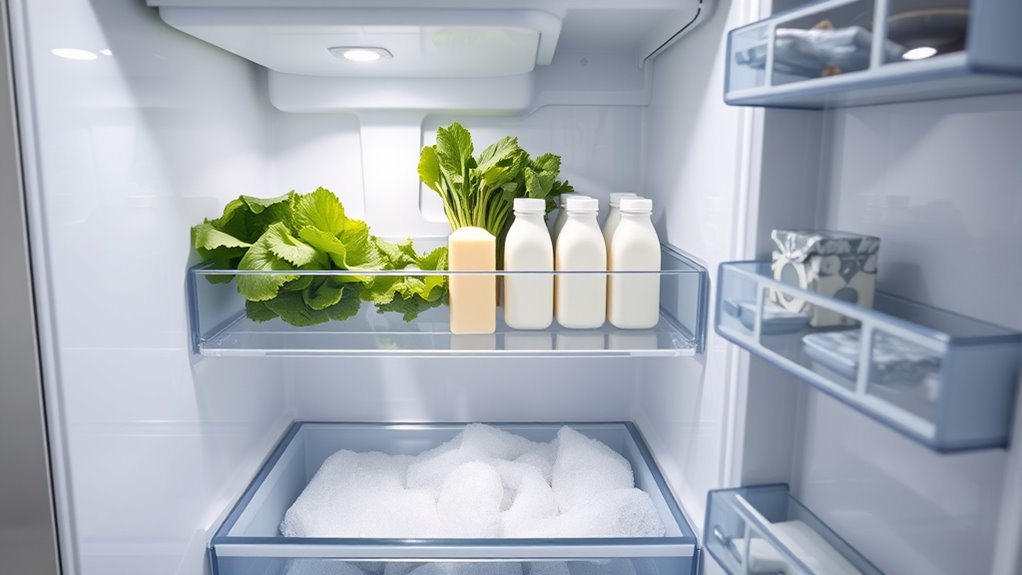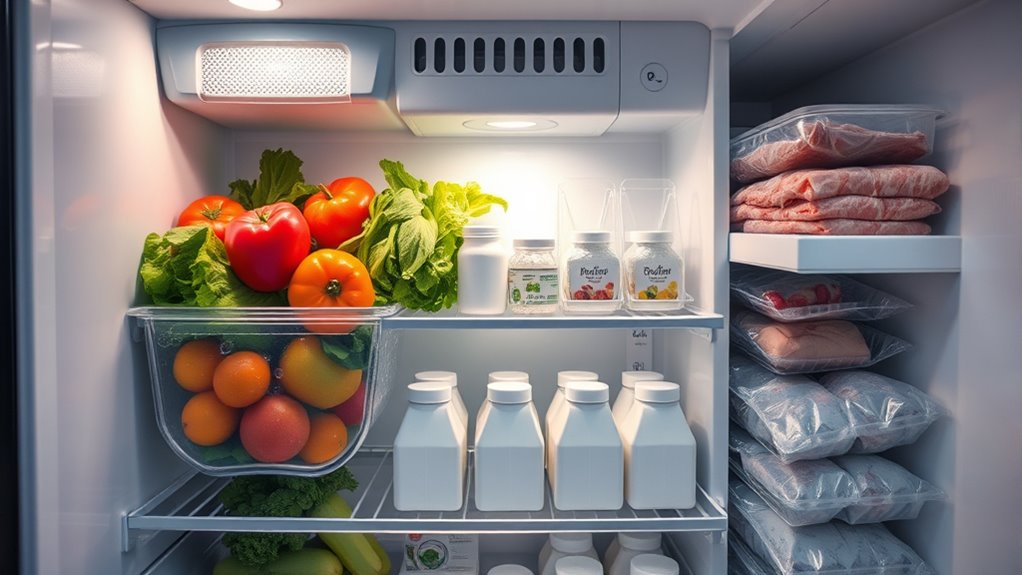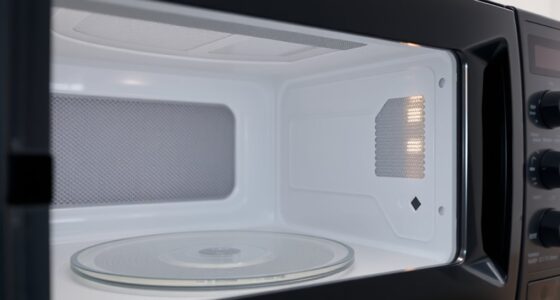To understand your fridge better, know that crispers are at the bottom, keeping fruits and veggies fresh by controlling humidity. The dairy section maintains a cooler, consistent temperature ideal for milk and cheese. The freezer zone, usually at the top or separate, preserves food long-term by freezing at around 0°F. Using each compartment correctly helps keep food fresh longer and reduces waste. Keep exploring to learn how to optimize your fridge for maximum efficiency.
Key Takeaways
- Crisper drawers are located at the bottom of the fridge and control humidity levels for optimal fruit and vegetable storage.
- Dairy compartments maintain a colder, consistent temperature ideal for preserving milk, cheese, and yogurt.
- Freezer zones are at the top or separate area, providing temperatures around 0°F (-18°C) for long-term food storage.
- Proper use of each compartment extends food freshness, prevents spoilage, and improves fridge efficiency.
- Segregating foods based on storage needs enhances food safety, reduces waste, and keeps perishables fresh longer.

Have you ever wondered why your refrigerator has different compartments? It’s all about food preservation and maintaining ideal temperature zones. Each section is designed to keep your food fresh longer while preventing spoilage. When you understand how these compartments work, you can make smarter choices about where to store your groceries, ensuring they stay healthier and taste better.
The crisper drawers are typically located at the bottom of your fridge and are specially designed for fruits and vegetables. These sections help regulate humidity levels, which is essential for food preservation. High humidity keeps produce from wilting or drying out, while lower humidity settings prevent mold and rot. By storing produce in these compartments, you’re taking advantage of the controlled environment, which extends the freshness of your fruits and vegetables. Remember, the temperature zones are carefully calibrated here to slow down decay and keep your produce crisp for days longer than if left on the shelf.
Moving up, the dairy compartment is usually situated in a dedicated section or on a designated shelf. This zone maintains a colder, more consistent temperature ideal for dairy products like milk, cheese, and yogurt. Since dairy items are highly perishable, keeping them at the right temperature is essential for food safety and quality. If you store dairy in a warmer part of the fridge, it can spoil quickly, leading to waste and potential health risks. By placing these items in the dairy compartment, you’re leveraging the fridge’s temperature control to preserve flavor, texture, and nutritional value.
The freezer zone is at the top or in a separate compartment altogether, offering a much colder environment than the refrigerator. It’s designed for long-term food preservation, locking in nutrients and preventing bacteria growth. Freezing halts the decay process, making it perfect for storing meat, leftovers, and frozen produce. The key here is maintaining a consistent, low temperature, typically around 0°F (-18°C), to keep food safe and prevent freezer burn. When you store items correctly in the freezer, you’re effectively extending their shelf life without sacrificing quality.
Understanding these compartments and their respective temperature zones allows you to organize your fridge more effectively. Proper placement of food not only helps with food preservation but also reduces waste and saves money. Additionally, awareness of food safety principles ensures that perishable items are stored properly to prevent health risks. By knowing which items need specific conditions, you’re ensuring your groceries stay fresh and safe for longer. This knowledge empowers you to maximize your fridge’s efficiency, making food storage less stressful and more effective.
Frequently Asked Questions
How Often Should Refrigerator Seals Be Replaced?
You should replace your refrigerator seal when you notice signs of seal deterioration, like gaps, cracks, or air leaks. Regular refrigerator seal maintenance helps keep your food fresh and energy bills low. Typically, seals last about 5 to 10 years, but if you see moisture buildup or inconsistent temperatures, it’s time to substitute them. Keep an eye on these signs to ensure your fridge stays efficient and properly sealed.
Can I Store Fresh Herbs in the Crisper?
Yes, you can store fresh herbs in the crisper for herb preservation. Many believe the crisper creates a humid environment ideal for keeping herbs fresh longer. To optimize fresh herb storage, wrap herbs in a damp paper towel and place them in a perforated plastic bag inside the crisper. This method helps maintain moisture levels, preventing herbs from wilting and ensuring they stay flavorful for days.
What’s the Ideal Temperature for the Dairy Zone?
The ideal temperature for the dairy zone is around 34°F to 40°F (1°C to 4°C). To keep your dairy fresh, follow dairy storage tips like keeping cheese, milk, and yogurt in the coldest part of the fridge, usually on the middle or lower shelves. Maintaining this beneficial dairy temperature prevents spoilage and preserves flavor, so check your fridge’s thermometer regularly to guarantee consistent cooling.
How Do I Prevent Freezer Burn?
To prevent freezer burn, make certain you use ideal storage techniques like tightly wrapping foods in airtight packaging or aluminum foil. Remove excess air from bags before sealing, and store items at a consistent, cold temperature—around 0°F. Label packages with dates to track freshness, and avoid opening the freezer too often. These steps help maintain food quality and keep freezer burn at bay.
Are There Specific Foods Best Stored in the Freezer?
You should store foods like frozen fruit and meat in the freezer for long-term preservation. Keep meat tightly wrapped to prevent freezer burn and maintain quality, while frozen fruit should be stored in airtight containers to retain flavor and texture. Always label packages with dates, so you use older items first. Proper storage guarantees your food stays fresh, safe, and delicious until you’re ready to enjoy them.
Conclusion
Now that you know the secrets behind each compartment, imagine what you could discover next—perhaps a hidden corner of freshness or a forgotten treat. Your fridge isn’t just a storage space; it’s a mystery waiting to be explored. As you open its doors, wonder what fresh surprises await in the crispers, dairy zone, or freezer. Keep exploring—you never know what delicious discovery might be just around the corner.









